by Doug Weber
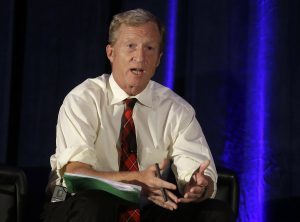
Billionaire environmentalist Tom Steyer pushed the environmental interests industry into seventh place in 2014 and 2016, among all industries.
As hot an issue as the environment has been in recent years, there’s never been much money in it for politicians. People who work for environmental advocacy groups, for instance, tend not to have a lot of extra scratch to contribute to candidates and parties, and political action committees in the field are generally modestly funded.
So why, after never having cracked the Center for Responsive Politics‘ 50 top-giving industries and interest groups, have environmental interests suddenly shot into seventh place in the 2014 and 2016 election cycles?
The answer is one Supreme Court decision plus one man. The decision, of course, is Citizens United, the 2010 ruling that allows corporations, unions and individuals to spend unlimited amounts to advocate for a candidate’s election or defeat as long as that spending isn’t coordinated with the candidate.
The man is Tom Steyer, billionaire environmentalist and hedge fund manager.
Take a look at the following chart:
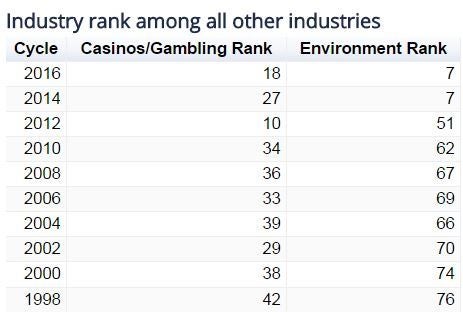
Propelling the rise of environmental interests was the fact that Steyer contributed 85 percent of that interest group’s contributions, or $73.9 million, in the 2014 cycle and 78 percent, or $87 million, in 2016.
Casinos and gambling make up another industry whose rankings have soared, from 36th in 2008 to 18th in 2016 (and it was as high as 10th in 2012). That’s due to the political engagement of Las Vegas Sands casino owner Sheldon Adelman. Adelson accounted for 62 percent, or $43.6 million, of the contributions from the industry in the 206 cycle.
This is part of a trend of relatively few large donors dominating campaign contributions since the Citizens United decision. On average, the top individual donor for an industry accounted for 10 percent of the contributions from that industry in the 2016 cycle, a higher percentage than ever before.
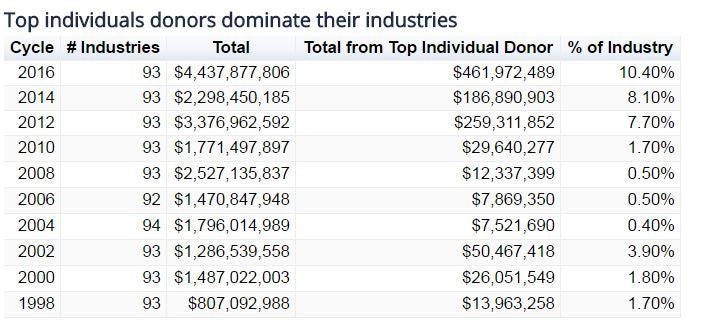
Prior to 2002, when the Bipartisan Campaign Reform Act was passed, individuals, corporations and unions could make unlimited contributions to the political parties, called “soft money.” During that period, the top individual donors in each industry averaged as much as nearly 4 percent of contributions from that industry. After that law took effect, the top donors’ share dropped below 1 percent.
In the wake of Citizens United, there was a dramatic increase in contributions from the top donors in each industry, well beyond the levels of the soft money era. In 2016, for the first time individuals accounted for half or more of the contributions from five interest groups or industries that gave more than $1 Million.
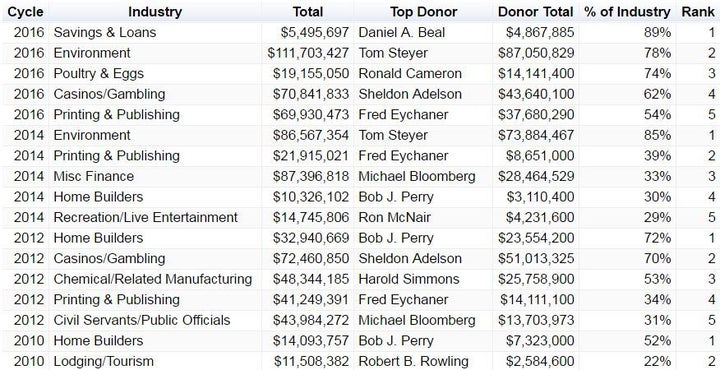
Leaving aside consideration of industries, the shift that has allowed a small group of political donors to account for a larger and larger share of the contributions total has been dramatic.
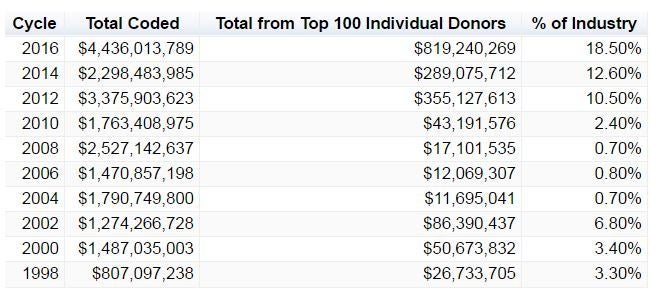
Post Citizens United, the top donors’ share of contributions jumps from a fraction of a percent in 2008 to close to one-fifth of contributions in the 2016 cycle. Furthermore, these individual donors have much more control of their money than they did in the soft money era: Rather than simply handing it over to the Democratic or Republican parties, they can direct it to groups benefiting particular candidates. In the second decade of the 21st century, the biggest individual donors have assumed a far greater role in elections than we’ve seen in generations.
